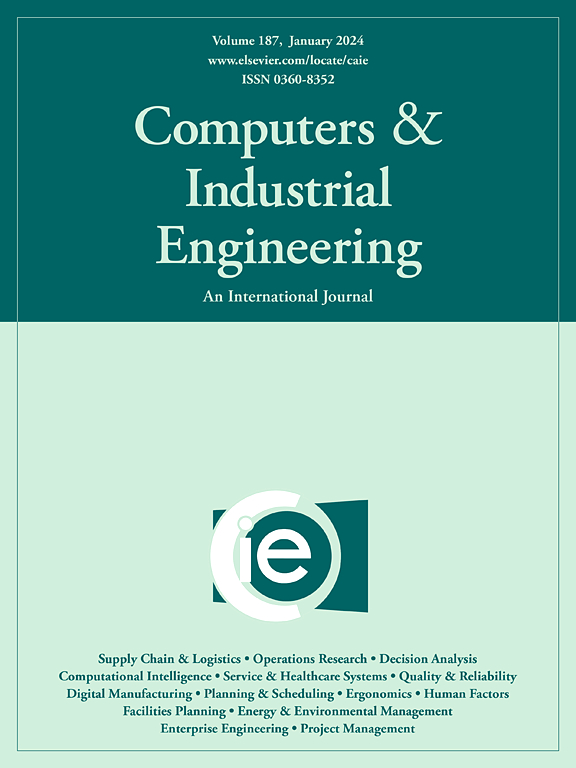A bi-objective optimization approach for multi-echelon supply network disruption risk assessment and critical supply path identification
IF 6.5
1区 工程技术
Q1 COMPUTER SCIENCE, INTERDISCIPLINARY APPLICATIONS
引用次数: 0
Abstract
This study tackles the critical challenge of managing uncertainty and disruption risk in multi-echelon supply networks (SNs) under data scarcity. We propose a novel bi-objective optimization approach integrating Bayesian Networks (BNs) and information theory to simultaneously assess disruption risk and identify the critical supply path. To address data scarcity and inherent ambiguity, BN parameters (probabilities) are represented as interval values. Entropy and information gain are used to quantify uncertainty and the value of supplier information. Two nonlinear optimization models are developed to find pareto optimal solutions representing the trade-off between minimizing the downstream manufacturer’s fully disrupted probability (reflecting operational continuity concerns) and maximizing the total information gain obtainable from supply paths (guiding uncertainty reduction efforts). The models explicitly consider two crucial scenarios based on whether the manufacturer initially possesses information about none or some of its direct suppliers. We employ a problem-specific Non-dominated Sorting Genetic Algorithm II (NSGA-II) to solve the models. Experimental results on various SN topologies demonstrate the framework’s effectiveness. Findings indicate that identifying the critical supply path via information gain provides valuable insights for anticipating risks and strategically reducing uncertainty. Importantly, the determination of the critical supply path and the nature of the trade-off between risk and informational advantage are shown to be significantly influenced by both the SN’s topological structure and the manufacturer’s initial information state. This research offers a comprehensive decision support tool for enhancing SN resilience under uncertainty.
多级供应网络中断风险评估和关键供应路径识别的双目标优化方法
本研究解决了在数据稀缺的情况下管理多级供应网络(SNs)中的不确定性和中断风险的关键挑战。我们提出了一种新的双目标优化方法,结合贝叶斯网络和信息论来同时评估中断风险和识别关键供应路径。为了解决数据稀缺性和固有的模糊性,BN参数(概率)被表示为区间值。利用熵和信息增益来量化供应商信息的不确定性和价值。开发了两个非线性优化模型来寻找帕累托最优解,以表示在最小化下游制造商的完全中断概率(反映操作连续性问题)和最大化供应路径可获得的总信息增益(指导减少不确定性的努力)之间的权衡。这些模型明确考虑了两种关键情况,即制造商最初是否拥有关于其直接供应商的信息。我们采用一种针对特定问题的非支配排序遗传算法II (NSGA-II)来求解模型。在各种SN拓扑上的实验结果证明了该框架的有效性。研究结果表明,通过信息获取确定关键供应路径为预测风险和战略性地减少不确定性提供了有价值的见解。重要的是,关键供应路径的确定以及风险与信息优势之间权衡的性质受到供应链拓扑结构和制造商初始信息状态的显著影响。本研究为不确定条件下增强SN弹性提供了综合决策支持工具。
本文章由计算机程序翻译,如有差异,请以英文原文为准。
求助全文
约1分钟内获得全文
求助全文
来源期刊

Computers & Industrial Engineering
工程技术-工程:工业
CiteScore
12.70
自引率
12.70%
发文量
794
审稿时长
10.6 months
期刊介绍:
Computers & Industrial Engineering (CAIE) is dedicated to researchers, educators, and practitioners in industrial engineering and related fields. Pioneering the integration of computers in research, education, and practice, industrial engineering has evolved to make computers and electronic communication integral to its domain. CAIE publishes original contributions focusing on the development of novel computerized methodologies to address industrial engineering problems. It also highlights the applications of these methodologies to issues within the broader industrial engineering and associated communities. The journal actively encourages submissions that push the boundaries of fundamental theories and concepts in industrial engineering techniques.
 求助内容:
求助内容: 应助结果提醒方式:
应助结果提醒方式:


